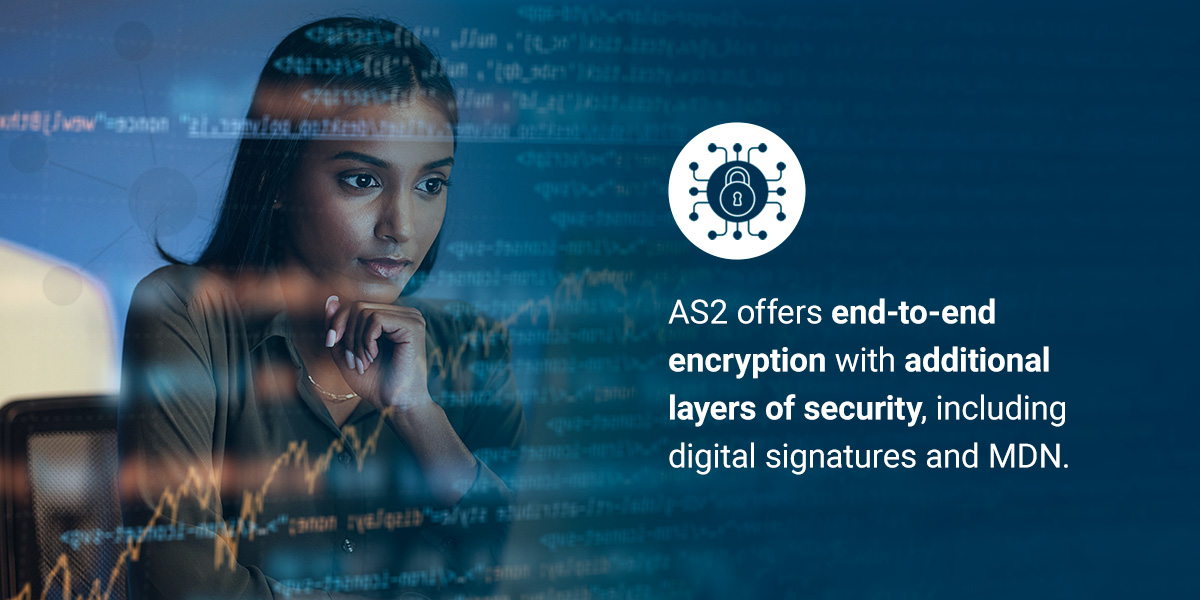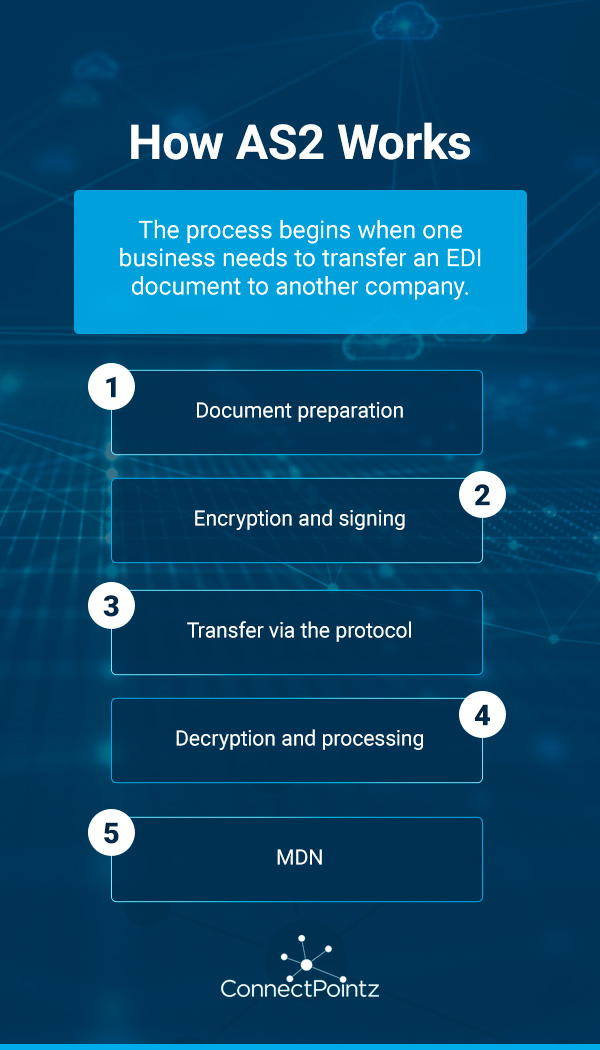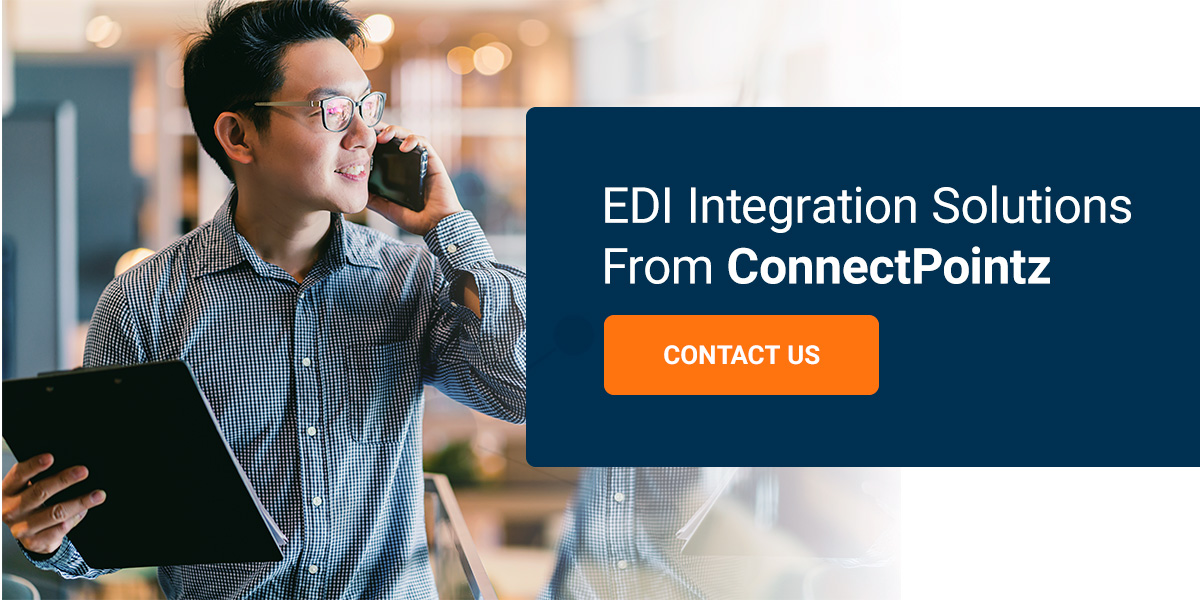
The secure exchange of confidential information is a fundamental requirement for modern businesses and organizations. Among the various data transfer protocols available today, Applicability Statement 2 (AS2) is a flexible solution that can guarantee file transfers are aligned with industry standards. With its ability to encrypt and verify delivery through digital signatures and Messages Disposition Notifications (MDNs), AS2 is fast becoming the standard for industries that need secure file transfers.
If you manage supply chains, oversee IT infrastructure or lead business operations, finding a reliable and efficient protocol is crucial. This guide will give you insights into the role of AS2 and how it can streamline your workflow.
What Is the AS2 Protocol?
AS2 is a communication protocol used to exchange business documents over the internet. Its primary purpose is to facilitate the transfer of Electronic Data Interchange (EDI) messages between businesses. This protocol is widely used across various sectors, including retail, manufacturing and logistics, to ensure secure and fast supply chain information exchange.
AS2 uses end-to-end encryption and authentication, which provides a much higher level of security. It also uses HTTP/S for transport, which allows businesses to use existing internet infrastructure instead of setting up dedicated lines for document exchange. AS2 also provides MDNs, a digital receipt, to confirm the recipient has received the document and that no message is lost in transit.
What Is AS2 Connection?
The AS2 connection is the actual link between two merchants to exchange business documents. The AS2 protocol lays out the rules or criteria for secure communication, but the connection is the pipeline through which those encrypted and signed documents travel, ensuring data integrity from sender to recipient.
Key Features of AS2
AS2 has several standout features that make it a reliable choice for secure document exchange.
End-to-End Encryption
AS2 encrypts your data to protect the sensitivity of business information. This layer of safety guarantees that invoices, purchase orders, shipping documents and any other confidential information are only readable by the intended recipient, preventing data breaches.
Digital Signatures
Every document sent via AS2 is digitally signed, providing proof that it came from a trusted source and hasn't been tampered with. This adds a level of accountability and trust between you and your trading partners, reducing the risk of fraud or data manipulation.
Real-Time Document Delivery
Unlike methods like email or FTP, AS2 supports real-time document delivery. This means your files are delivered almost instantly, and your trading partner can begin processing them immediately. This speed is especially beneficial for time-sensitive transactions, such as placing an urgent order or updating inventory.
Message Disposition Notification
After your document is delivered and decrypted, the recipient's system automatically sends you a confirmation receipt. This receipt verifies the data was successfully received and processed, giving you complete traceability and peace of mind.
Data Compression
AS2 can reduce file sizes, helping optimize bandwidth usage. This compression is particularly useful when transferring large files or handling high volumes of transactions. Compression means your business can experience faster data transfers and reduced storage costs.
AS2 vs. SFTP
Secure File Transfer Protocol (SFTP) is a secure method for transferring files over a network using Secure Shell (SSH) encryption. It provides a way to transfer data between systems so files cannot be intercepted during transfer. SFTP is commonly used for file transfers, which, similar to AS2, ensures confidentiality and integrity by encrypting the file during transfer. SFTP is widely used because of its simplicity and secure encryption. However, it is best suited for less complex file transfers.
Both protocols provide a secure way to transfer files, but each is better suited for specific business needs. Here's a look at how they differ:
Security and Encryption

AS2 offers end-to-end encryption with additional layers of security, including digital signatures and MDN.
SFTP also provides secure file transfer through SSH, which can encrypt the transferred data, providing solid protection against unauthorized access. However, it lacks the same level of validation and verification as AS2.
Delivery Confirmation and Tracking
AS2 uses MDNs, and these notifications serve as a receipt to confirm the recipient has received and decrypted the file. This feature gives businesses peace of mind, knowing the exact status of every transfer and helps avoid disputes or confusion over whether a document was delivered.
SFTP doesn't send an automatic acknowledgment when a file is received or decrypted, making it less reliable for businesses that need real-time delivery confirmations.
Integration and Automation
With AS2, businesses can automate and streamline EDI communications, ensuring that documents are transferred without manual intervention. AS2 is built to integrate with Enterprise Resource Planning (ERP) systems, online marketplaces and other business connectors.
SFTP can also be integrated into systems but often requires more manual processes to manage files and transfers. This lack of automated workflow can lead to errors during transfer.
What Is AS2 EDI?
EDI is a method businesses use to transfer documents electronically. It allows companies to streamline transactions and automate processes that would otherwise be manual, time-consuming and prone to errors. EDI focuses on standardizing documents and transmitting them electronically, but it may not be the most secure way to exchange documents — that's where AS2 comes in.
Simply put, EDI determines what businesses exchange, and AS2 provides security around how companies exchange it. The AS2 EDI connection allows businesses to automate workflows, guaranteeing transactions occur in real time without human intervention, errors or delays. Many large organizations require AS2 as the protocol for exchanging EDI messages because of its ability to handle high volumes of transactions with full compliance with industry security standards.
For example, major retailers such as Walmart require their trading partners to use AS2 to send EDI documents because it provides a unified standard for communication across the supply chain.
Explaining the Relationship Between AS2 and EDI
EDI is the standard for exchanging business documents electronically, while AS2 provides a secure protocol for those documents to be shared. In essence, AS2 is the transport mechanism for EDI communications. Businesses choose AS2 for EDI because:
- It's reliable and highly secure.
- It eliminates the need for VANs or private networks.
- It simplifies real-time document transfer tracking.
How AS2 Works

So, how does AS2 actually function in practice? The process begins when one business needs to transfer an EDI document to another company. The process of exchanging documents through the protocol includes:
- Document preparation: The sender creates a purchase order and invoice and formats it in EDI or according to the agreed-upon standards between the trading partners.
- Encryption and signing: The file is then encrypted and signed with the sender's digital certificate to warrant confidentiality and authentication. The encryption ascertains that only the intended recipient can access the information, while the digital signature verifies the document came from a trusted source.
- Transfer via the protocol: The encrypted document is sent over the internet using HTTP/S, which ensures no unauthorized parties can intercept or alter the file during its journey.
- Decryption and processing: The recipient decrypts the file using their private key, verifies the digital signature and processes the document into their system using their AS2 software.
- MDN: Once the recipient receives and decrypts the file, they send back an MDN to confirm it was received.
If any part of the process fails, an error message is generated, which allows you to troubleshoot and resend if necessary.
Benefits of AS2
AS2 streamlines data transfer. Here's why it's an invaluable asset for merchants that rely on EDI.
Increased Efficiency
By automating the exchange of business documents, AS2 minimizes time-consuming manual processes. This automation allows you to save countless hours that would otherwise be spent on data entry and review. Additionally, because the protocol enables real-time communication, documents are transported almost instantly. This rapid data exchange reduces delays and guarantees processes run seamlessly.
Improved Security
End-to-end encryption protects data from interception or tampering while it's in transit. If you're transferring financial information, customer information or propriety business documents, you can trust that your data is secure throughout the process. The use of digital signatures adds another layer of protection by authenticating the sender's identity and confirming the document has not been altered.
Cost-Savings

AS2 allows you to exchange documents online, eliminating the need for costly Value-Added Networks (VANs) or dedicated communication lines. This reduction in infrastructure costs makes it an attractive option for organizations of all sizes. Additionally, automating the exchange of documents via the protocol reduces labor costs by minimizing manual detail entry and reducing errors.
Compliance
Many industries require trading partners to meet specific compliance standards for document exchange. AS2 is widely recognized and accepted as a compliant method for EDI exchanges, helping businesses meet regulatory requirements.
Scalability
As businesses expand, so too do their needs. If you're adding new trading partners or handling a higher volume of transactions, AS2 accommodates these changes without requiring significant IT overhauls. Additionally, the protocol's adaptability allows businesses to react swiftly to market changes, such as sudden spikes in demand during peak seasons.
Global Standard
AS2 is a globally recognized protocol used by many of the world's largest companies. Adopting the protocol allows you to exchange documents confidently with international partners without worrying about compatibility or security issues.
Reduced Errors
Manual processes are prone to mistakes, whether from human error or miscommunication. AS2 reduces these risks by automating file transfers and reducing human involvement, which decreases the chance of errors. This means fewer issues with incorrect orders or missing invoices between trading partners. Because AS2 includes MDNs, these notifications create a feedback loop that allows businesses to detect and resolve any issues, fostering smooth communication between trading partners.
Improved Customer Service
With the protocol's real-time data exchange capabilities, businesses can respond to customer inquiries or orders much more swiftly. For instance, when customers place an order, AS2 allows merchants to instantly process and confirm that order, leading to faster fulfillment and, ultimately, higher customer satisfaction.
AS2 Integration
When implementing AS2, one of the main concerns is often about how well it will integrate with your existing systems. The good news is that the protocol is generally flexible and connects through existing software or third-party platforms. Most AS2 clients or connectors offer seamless integration options, so once the initial setup is complete, everything works in the background.
Setting up AS2 integration usually involves:
- Identifying trading partners: Businesses first determine which partners they will be exchanging EDI documents with, such as suppliers or logistics companies.
- Exchanging digital certificates: AS2 uses public key infrastructure (PKI) for encryption and digital signatures. Before exchanging documents, both partners need to exchange digital certificates to authenticate the sender's identity and ensure documents remain encrypted during transmission. Each company generates and manages its own certificate. You'll also need to update these certificates periodically to maintain security compliance and ensure encryption protocols remain current.
- Configuring AS2 endpoints: Once you and your trading partner have exchanged certificates, the next step is to configure the AS2 endpoints. An AS2 endpoint is the server or address where your trading partner will send and receive documents. Both parties must configure their systems with the correct URLs, ports and IP addresses so data is directed to the right place.
- Testing AS2 connection: When you've completed the configuration step, test the connection to verify that everything works as expected. Testing also allows you to identify and fix any configuration issues. This process involves sending and receiving test documents to confirm the data is encrypted and transmitted securely and MDNs are generated properly. You can also send different EDI documents to verify the connection handles various formats and transaction types.
EDI Integration Solutions From ConnectPointz
At ConnectPointz, we understand the importance of seamless document exchange and offer a range of services designed to help you integrate AS2 and EDI into your workflows. Our EDI compliance solutions ensure your business meets industry standards and trading partner requirements, allowing you to focus on what matters most — growing your business. If you are looking to streamline order processing, our order automation service enables real-time data exchange, reducing manual labor and minimizing errors.
We also specialize in third-party connectors and application integration, making it easier for you to connect with platforms and other e-commerce systems. These solutions are also custom-tailored to meet your unique needs. With a quick and easy onboarding process for new merchants, we help businesses get up and running in no time. Our services are flexible, affordable and designed to scale with your business as you grow. Contact us today for a free demo and see firsthand how we can simplify your document exchange processes.










































